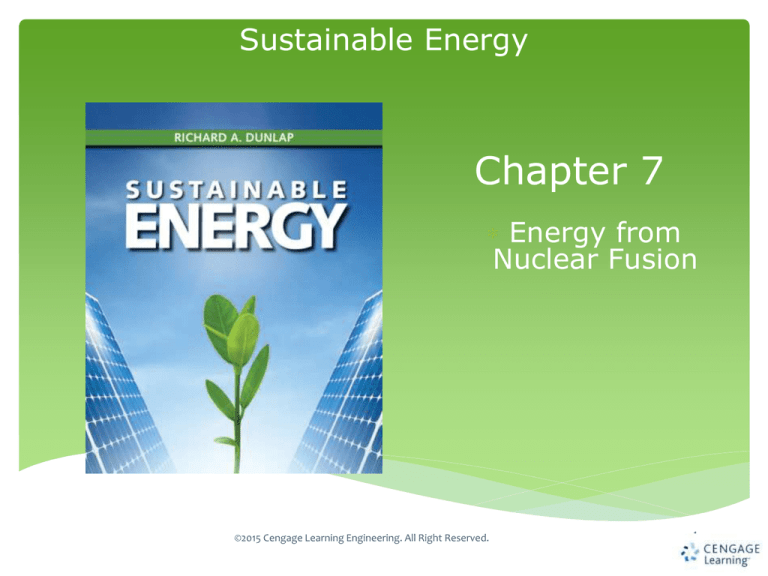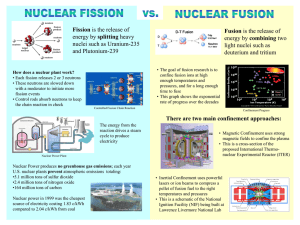
Sustainable Energy
Chapter 7
Energy from
Nuclear Fusion
©2015 Cengage Learning Engineering. All Right Reserved.
1
Sustainable Energy
Dunlap
Learning Objectives
●
●
●
●
●
●
The properties of fusion reactions and the
production of fusion energy.
The design and operation of magnetic
confinement reactors.
The design and operation of inertial
confinement reactors.
The importance of the Lawson criterion.
The design of a fusion power reactor.
Progress toward a viable fusion reactor.
©2015 Cengage Learning Engineering. All Right Reserved.
2
Sustainable Energy
Dunlap
Advantages over nuclear fission
• Fusion processes are inherently more stable and
can be readily stopped
• Utilizes inexpensive and plentiful fuel (maybe)
• Produces no hazardous waste products
©2015 Cengage Learning Engineering. All Right Reserved.
3
Sustainable Energy
Dunlap
Energy from nuclear fusion
Nuclear binding energy can be converted into kinetic energy
by fusing together two light nuclei as shown by the binding
energy per nucleon curve.
©2015 Cengage Learning Engineering. All Right Reserved.
4
Sustainable Energy
Dunlap
Proton-proton (p-p) fusion
The simplest fusion process is the binding together of two
protons (or 1H nuclei):
Because the positron and a neutrino are involved in this
process it is dominated by the week interaction and
proceeds very slowly.
©2015 Cengage Learning Engineering. All Right Reserved.
5
Sustainable Energy
Dunlap
Deuteron-deuteron (d-d) fusion
Two deuterons (2H nuclei) can be fused without the
need for the weak interaction by the processes
and
©2015 Cengage Learning Engineering. All Right Reserved.
6
Sustainable Energy
Dunlap
Deuteron-triton (d-t) fusion
A deuteron (2H nucleus) and a triton (3H nucleus) can also be
fused by the process
©2015 Cengage Learning Engineering. All Right Reserved.
7
Sustainable Energy
Dunlap
Cross sections for d-d and d-t fusion
Cross sections show that d-t fusion will be easier
to achieve than d-d fusion
©2015 Cengage Learning Engineering. All Right Reserved.
8
Sustainable Energy
Dunlap
Coulomb barrier
In order to fuse two nuclei together it is necessary
to overcome the Coulombic repulsion of the
positively charged protons.
It is necessary that the nuclei are at high enough
energy and are kept close enough together for long
enough that fusion will occur.
The Lawson criterion for density and confinement
time must be satisfied
©2015 Cengage Learning Engineering. All Right Reserved.
9
Sustainable Energy
Dunlap
Approaches to fusion
Two approaches can be used to achieve fusion
• Magnetic confinement
• Inertial confinement
(sometimes called laser fusion)
©2015 Cengage Learning Engineering. All Right Reserved.
10
Sustainable Energy
Dunlap
Magnetic confinement
At high temperature all gas atoms are ionized creating a plasma.
The charged particles of the plasma can be controlled by
electromagnetic fields.
The Tokamak, which uses a toroidal field geometry
is the cost common.
©2015 Cengage Learning Engineering. All Right Reserved.
11
Sustainable Energy
Dunlap
Confinement of plasma in
a toroidal field geometry
©2015 Cengage Learning Engineering. All Right Reserved.
12
Sustainable Energy
Dunlap
Basic Tokamak design
©2015 Cengage Learning Engineering. All Right Reserved.
13
Sustainable Energy
Dunlap
Interior of a "spherical" Tokamak
©2015 Cengage Learning Engineering. All Right Reserved.
14
Sustainable Energy
Dunlap
Inertial confinement fusion
Steps to Laser fusion
(a) irradiation of fuel pellet
with Laser
(b)Heating of outer portion
of pellet
(c) Ablation of outer portion
of pellet
(d) Compression of core
by inertial forces
©2015 Cengage Learning Engineering. All Right Reserved.
15
Sustainable Energy
Dunlap
Lawrence Livermore Laser fusion experiment
©2015 Cengage Learning Engineering. All Right Reserved.
16
Sustainable Energy
Dunlap
Laser fusion experimental conditions
d-t fuel pellet - typically 1 mg
Laser power - 750 TW
(50 times total average world
power consumption)
Laser pulse duration - 2.4 ns
Energy per laser pulse (750 TW)x(2.4 ns) = 1.8 MJ
©2015 Cengage Learning Engineering. All Right Reserved.
17
Sustainable Energy
Dunlap
density - confinement time relationships for
different fusion experiments
©2015 Cengage Learning Engineering. All Right Reserved.
18
Sustainable Energy
Dunlap
Progress towards fusion energy
(Magnetic Confinement Reactors)
©2015 Cengage Learning Engineering. All Right Reserved.
19
Sustainable Energy
Dunlap
Progress towards fusion energy
(Inertial Confinement Reactors)
©2015 Cengage Learning Engineering. All Right Reserved.
20
Sustainable Energy
Dunlap
Where does fuel come from?
d-d fusion is much more difficult than d-t fusion so current
experiments focus on d-t fusion.
Deuterium from sea water - one hydrogen out of 6410 is
deuterium - more or less unlimited
Tritium is unstable (half life = 12 years) and must be made
artificially by the reaction
Limited by the world's supply of lithium
©2015 Cengage Learning Engineering. All Right Reserved.
21
Sustainable Energy
Dunlap
Basic design of a fusion reactor
©2015 Cengage Learning Engineering. All Right Reserved.
22
Sustainable Energy
Dunlap
Challenges to fusion energy
• Need to achieve net energy gain
• Need to account for Carnot efficiency of electricity
generation
• Need to make energy economically competitive
• Need to consider fuel availability
(if tritium is used, lithium supply might last
500 - 1000 years)
• Need to consider competition for lithium supplies
(for rechargeable batteries)
©2015 Cengage Learning Engineering. All Right Reserved.
23
Sustainable Energy
Dunlap
Summary
• Nuclear binding energy can be released during the fusing
together of light nuclei
• Safer and more environmentally conscious than fission
• d-t fusion most likely to be feasible
• Two basic approaches o Magnetic confinement and
o Inertial confinement (Laser fusion)
• Needs to be energetically and economically viable
• d-t fusion requires lithium to breed fuel
©2015 Cengage Learning Engineering. All Right Reserved.
24



